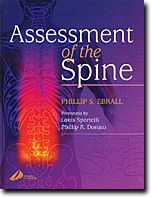|
|
Assessment of the Spine
Book Review
by
Jonice Owen, DC
| Title: |
Assessment of the Spine |
| Author: |
Phillip S. Ebrall, BappSc (Chiropractic), PhD, FICC
|
| Publisher: |
Churchill Livingston, 2004
|
| Part #: |
T-258 |

Assessment of the Spine by Phillip S. Ebrall is a long-awaited upgrade of chiropractic educational material. This wonderfully organized, pertinent text synthesizes the thought processes of various courses of chiropractic education, treatment choices and patient care and management. The author is the senior lecturer in chiropractic and program leader at the Royal Melbourne Institute of Technology (RMIT) in Melbourne, Australia. He conveys his vast experience proficiently. Although it is wordy and sometimes overly precise, the text is clear and unbiased. Some of this may be attributable to the direct effect of an extensive editorial advisory board.
Part I: Assessment Principles and Procedures, "describes the components of assessment and the principles which underpin this vital clinical process." The eight chapters are educational and would be beneficial for any chiropractic physician intent upon clearing out dated college texts to upgrade his or her current information. The text is well-founded in background material and at-a-glance usability.
Part 2: Assessment of the Spine by Region, does just what the title implies. Dr. Ebrall begins with the upper cervical spine, and then proceeds through the midcervical spine, cervicothoracic spine, midthoracic spine, thoracolumbar spine, and finally the lumbopelvic spine. The segmental analysis precedes global spinal assessment, thereby correlating mechanical and holistic approaches to spinal assessment. The synthesis of this information is advanced to further clinical applicability in Part 3: Documentation, Interpretation and Communication, which discusses patient history, outcomes measurement, etc.
Dr. Ebrall understands chiropractic and what is required to think "chiropractically" as a neuromusculoskeletal system specialist. "This book is written for the student who wants to build a comprehensive set of practical skills for the clinical assessment of the spine...The intent of this text is to guide the development and attainment of high-order clinical skills to assess the spine for the purpose of better directing therapeutic intervention which restores normal function and health."
One drawback for doctors of chiropractic is the writing, which tends to be dry and academic in places. Another pitfall of this text is the lack of reference or instruction to accessing the Internet, doing literature searches and/or following protocol, which would lead the doctor to evidence-based medical practices. Even though it is basic information, it could easily expand to include this timely, necessary information for future and present doctors of chiropractic.
As a chiropractic college text, I rate this book 9.8 out of 10. As a reference text for practicing doctors of chiropractic, I rate this book 8.5 out of 10.
Dr.
Owen's
Rating:
 9.15 out
of 10 9.15 out
of 10
|

|








